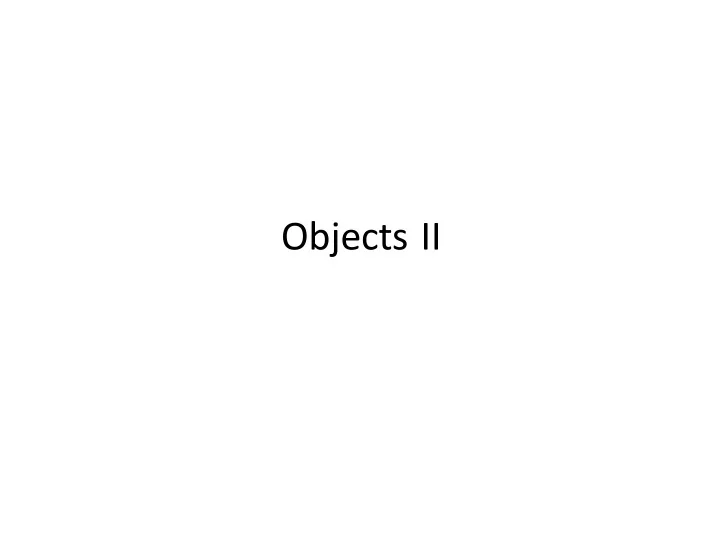

Objects II
• A class is a struct plus some associated functions that act upon variables of that struct type. – class = struct + functions • An object is a variable of some class type – aka "an instance of a class.” • In a class, the variables of that class are called fields ; the functions are called methods. – Together, the fields and methods are called members (book uses data members and member functions ).
class dog { Name of the class public: string name; Every dog has a name int age; Every dog has an age void bark(); }; Every dog has the ability to bark void dog::bark() { cout << name << "says woof!"; }
class dog { A class's methods are allowed to use the fields defined public: within that class as local variables. string name; int age; A method (normally) only has access to the fields for its void bark(); own object. }; void dog::bark() { cout << name << "says woof!"; }
void dog::bark() { cout << name << "says woof!"; } main dog mydog; mydog.name = "Fido"; mydog.age = 3; dog otherdog; otherdog.name = "Fluffy"; otherdog.age = 8; mydog.bark(); otherdog.bark();
void dog::bark() { cout << name << "says woof!"; main } main name: "Fido" mydog: age: 3 dog mydog; mydog.name = "Fido"; mydog.age = 3; dog otherdog; otherdog.name = "Fluffy"; otherdog.age = 8; mydog.bark(); otherdog.bark();
void dog::bark() { cout << name << "says woof!"; main } main name: "Fido" mydog: age: 3 dog mydog; mydog.name = "Fido"; otherdog: name: "Fluffy" mydog.age = 3; age: 8 dog otherdog; otherdog.name = "Fluffy"; otherdog.age = 8; mydog.bark(); otherdog.bark();
void dog::bark() { cout << name << "says woof!"; main } main name: "Fido" mydog: age: 3 dog mydog; mydog.name = "Fido"; otherdog: name: "Fluffy" mydog.age = 3; age: 8 dog otherdog; dog::bark() otherdog.name = "Fluffy"; otherdog.age = 8; mydog.bark(); otherdog.bark();
void dog::bark() { cout << name << "says woof!"; main } main name: "Fido" mydog: age: 3 dog mydog; mydog.name = "Fido"; otherdog: name: "Fluffy" mydog.age = 3; age: 8 dog otherdog; dog::bark() otherdog.name = "Fluffy"; otherdog.age = 8; mydog.bark(); otherdog.bark();
• Every time a method of a class is called, there is a special pass-by-reference variable created that points to the calling object. • When the method uses a variable name that is not found in that method, C++ tries to find it using the special reference variable.
• Most object-oriented (OO) programming languages allow us to specify fields and methods as public or private . • Private members can be used only by code inside the class’s methods. • Public members can be used by code inside or outside the class’s methods.
class A { int main() public: { int x; A obj1, obj2; void f(); obj1.x = 4; // ok private: obj1.y = 2; // error int y; void g(); obj2.f(); // ok } obj2.g(); // error }
Why have public and private? • Sometimes we need to hide certain variables or functions from the user of a class so the user doesn't accidentally screw things up. • This is called information hiding . • Used to protect the members of an object that should only be used by the person writing the class.
class dog { What could go public: wrong with age or string name; name being int age; public? void bark(); }; void dog::bark() { cout << name << "says woof!"; }
Good rule of thumb class dog { to make all fields public: void bark(); (variables) private unless you have a private: very good reason string name; not to. int age; }; void dog::bark() { cout << name << "says woof!"; }
main What is wrong dog mydog; with this code mydog.name = "Fido"; mydog.age = 3; now? dog otherdog; otherdog.name = "Fluffy"; otherdog.age = 8; mydog.bark(); otherdog.bark(); cout << "My dog is " << mydog.age << endl;
main What is wrong with dog mydog; this code now? mydog.name = "Fido"; mydog.age = 3; Red fields are private; cannot be dog otherdog; otherdog.name = "Fluffy"; used outside of the otherdog.age = 8; class now. mydog.bark(); otherdog.bark(); cout << "My dog is " << mydog.age << endl;
class dog { Add setters and public: getters. void bark(); void setName(string newName); string getName(); void setAge(int newAge); double getAge(); private: string name; double age; }; // rest of code on computer
• The public members of a class are known as the class's interface . – These members are what the users of your class see. – Generally describes what a class does. • The private members of a class are known as the class's implementation . – These are hidden from the user. – Generally describe how a class works. • We strive to keep a class's interface consistent over time. We can change the implementation any time we want.
What is in a car's interface and implementation?
class dog { public: ... (all the same stuff from before)... int getAgeAsHuman(); void setAgeAsHuman(double newAge); private: // Should we add double ageAsHuman? };
• To your dog class, add the ability for the dog to have some amount of energy. The dog's energy can never go below zero. • Edit print() so it displays energy as well. • Add a getter and a setter called getEnergy() and setEnergy(int newEnergy). Test your code. • Add a method for the dog to playFetch(). Playing fetch tires the dog out, so it lowers the dog’s energy by 1. Test your code. • Add a method for the dog to sleep for a certain number of hours. The dog's energy should be raised proportionally to the number of hours it sleeps. Test your code. • Extra: add a method called playWith(dog & buddy) to allow a dog to play with another dog. Playing with another dog lowers both dog’s energies. Test your code.
Recommend
More recommend